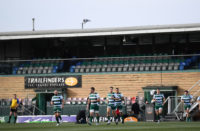 England will not be de-railed this season by skidding on the media and blog froth that has surrounded his squad since their record win over New Zealand a week ago. That was Stuart Lancaster's message in the aftermath of a resounding victory over the world champions, which was as welcome as it was unexpected.
England will not be de-railed this season by skidding on the media and blog froth that has surrounded his squad since their record win over New Zealand a week ago. That was Stuart Lancaster's message in the aftermath of a resounding victory over the world champions, which was as welcome as it was unexpected.
The England head coach also talked about his disappointment at not winning all three home matches against the Southern Hemisphere troika, with the Tests against Australia and South Africa lost, despite both visiting teams being heavily depleted by injuries.
In doing so, Lancaster highlighted England's most glaring flaw since 2003. Inconsistency. When it comes to being full of promise but failing to deliver England are in the same league as politicians with their election manifestos. Why did the Eureka moment of this, and many other autumn series', have to wait until England had their backs to the wall against New Zealand, facing a whitewash which would have seen Lancaster pilloried instead of praised, and his credentials to take the team forward to the 2015 World Cup found wanting?
We have seen these surges on a number of occasions over the last nine years, with the men in white reaching a peak only to plummet into a turbulent trough. After the dog days of 2005 and 2006, a player-takeover during the 2007 World Cup resulted in a Jekyll and Hyde England beating Australia and France in the knock-out stage to reach the final against a South Africa side which had demolished them 36-0 in the pool stages.
After losing that final narrowly, another slump followed in 2008 and 2009 until, two years ago, with Martin Johnson installed as coach, optimism took root after the drawn series on the 2010 summer tour to Australia, with England beating the Wallabies in Sydney. When Johnson's side trumped it by dismantling Australia 35-18 at Twickenham with an autumn performance that attracted almost as many superlatives as last weekend's victory over New Zealand, the road to the 2011 World Cup went from rocky to smooth.
A year later Johnson's outfit had gone down the gurgler long before last Saturday's hero, Manu Tuilagi, jumped off a ferry into Auckland Harbour, with the quarter-final defeat by France bringing an inglorious England World Cup campaign to a halt. With off-field antics looming far larger than on-field feats, England limped home to find that their dirty linen was aired in public after the leak of the internal report into their World Cup debacle.
Cue the appointment of Lancaster, and a culture shift that has stressed the fundamental tenets that there is no ‘i' in team, and that the England shirt is borrowed rather than owned. Graft onto that a steady selection process which, while it leans more towards being consistent than inspired, means that the head coach has earned the trust of his players, and you have the belts in place to buckle the squad together.
However, despite their team spirit, England remain inconsistent. They lost only to Wales in the Six Nations, but the results since then have shown just how far that tournament has fallen in terms of standards, if not in terms of theatre and atmosphere.
Lancaster's England were given a truer register of where they stand in the international pecking order by their summer and autumn tangles with the Southern Hemisphere big three, and the ledger, notwithstanding the once-in-a-decade victory over the All Blacks, is lost four, won one, drawn one.
While it is true that the margins of the three defeats by South Africa, and the single losses to Australia and Wales, have often been narrow (all under 10 points) due to England's tenacity and organisation in defence, it is offset by an attack that, with the exception of the blitzes against New Zealand last weekend and France last season, has failed to fire its own imagination – let alone that of the fans.

Lancaster's overall record shows the mixed bag with six wins, five losses, and a draw from his first 12 Tests in charge, and while it's tempting to trade in the first 11 of those results, good and bad, for a victory as comprehensive as that achieved by Chris Robshaw and company over the All Blacks, it would be short change. World Cup-winning teams, and sides who put together world-record winning runs, are by definition teams who back up good results time and again.
Some of the All Black players may have been tempting fate by saying in the build-up to playing an unfancied England that they were seeking the perfect performance – and some of their 19 wins were far from that – but in terms of finding ways to win even when they are not firing on every cylinder, New Zealand are peerless.
By contrast, before last weekend's totally unexpected pyrotechnics against New Zealand lit up Twickenham, England looked as if they were dead-ringers for the role of also-rans at their own 2015 World Cup party.
That is why Lancaster, who seems to have his feet firmly planted, will probably treat it as a freak result which shows what his team are capable of, rather than take it as a measure of the ferocity and accuracy they will summon in every one of their Six Nations encounters.
Great coaches never accept that champion teams cannot improve, and they also make substantial changes to promising teams even when they are winning. Some would say especially when they are winning, because making judicious changes in an environment of confidence and positive energy is better than making them when a team is hanging. Lancaster has a number of crucial selection conundrums to settle, with the back five of the pack still under scrutiny despite hitting the heights against New Zealand.

Joe Launchbury was the discovery of the autumn, making an impact as soon as he came on against Australia, and despite the young Springbok giant Eben Etzebeth nudging in front of him a week later, he was exceptional against the world champions. However, Launchbury, Geoff Parling and Courtney Lawes are all peas out of a similar physical pod – rangy and mobile (17-18st) – whereas the ideal partnership is to harness them with a heavyweight lock like Etzebeth or Australia's Sitaleki Timani (nearly 19st).
However, the likes of Bath's Dave Attwood will get back in contention only if he can make his size and abbrasiveness tell, while also matching the work-rate of the lighter men.
There are those who feel that the back row debate was settled this autumn, with Robshaw's sheer industry in the tackle and the loose marking him out as a high calibre Test openside. It did not.
Despite the captain's courage, footballing ability, and his tremendous work-rate, he does not have the pace of a Test No.7, or the ball-winning radar and split-second stealing instincts of someone who has played openside throughout their career.
You could argue that he outplayed his All Black counterpart Richie McCaw last weekend, but the counterpoint is that in this instance McCaw was nullified by the collective drive of the England pack. It is when that wave of white shirts at the breakdown is more fragmented that Robshaw has to excel as a ball-winner, spoiler, and support runner, as Australia's Michael Hooper did.
Robshaw is a highly effective blindside, and his overall talent means he can mix it as a Test openside when he is on the front foot – which is why he deserved his inclusion at No.7 in last week's Lions team from the autumn series. But it is not second nature to him.
Whether the two Saracens hopefuls, Andy Saull and Will Fraser, or Worcester's Matt Kvesic can upstage Robshaw on the domestic stage remains to be seen, but Luke Wallace's chances at Harlequins will probably be limited until the Six Nations.
The England back row will lack an important dynamic until there is more speed at openside, although there are riches at No.6 with Tom Wood the man in possession, James Haskell and Tom Johnson pitching, and Tom Croft to return from injury.
At No.8 Ben Morgan made sizeable strides in the last two Tests of the autumn, and if he adds greater physicality in defence to his strong carrying and handling he should hold onto the starting shirt, but after that the cupboard doesn't look well stocked. Jackson Wray is impressive on a regular basis for Saracens, and Lancaster could do with promoting the youngster to the EPS.
In midfield adding Freddie Burns and George Ford to the fly-half mix – Burns for his pace and Ford for his poise – would give England a different, more direct attacking dimension to that offered by Owen Farrell and Toby Flood.
As Jerry Guscott advocates on the adjoining pages, Lancaster also has to grasp the nettle and employ Manu Tuilagi as a Ma'a Nonu-style inside-centre, with Brad Barritt covering him. That leaves room for the introduction of a fast outside-centre like Jonathan Joseph or Jonny May, giving the England backline a classic power-speed centre blend.
Striking a similar balance in the back three is problematic because England have unearthed three Test standard full-backs in Ben Foden, Alex Goode and Mike Brown. Foden, who looked rusty in Northampton's Heineken Cup head-plant against Ulster on Friday night, has enough pace to manage on the left wing, whereas Brown and Goode do not. Yet, both are proven No.15s, and picking one leaves room on the right wing for Chris Ashton, who still tracks breaks better than any other English back.
It leaves England short of the sort of raw strike speed and agility on the wings that May, Charlie Sharples, Christian Wade and Tom Varndell possess, and, in the end, the trade-off is whether Lancaster wants the versatility of two footballing No.15s in his back three, or two rapid finishers.
These sticky selection issues will have a direct bearing on England continuing to advance and becoming a more consistent side, so how the head coach tackles them is crucial.
The unexpected bonus as he sets about his task is that for the first time since 2003 there is genuine competition for places, with the spin-off that peer-group pressure will push up standards.
2 Comments
Leave a Comment
You must be logged in to post a comment.



























Pingback: ai nude
Pingback: jarisakti